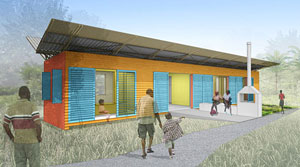 |
| Image courtesy ARCHIVE |
“Breathe House,” from a joint U.S. and U.K. team led by architect Anselmo Canfora, won first place. |
Exactly one year after an earthquake rocked Haiti, and months after a deadly cholera outbreak began, the winners of competition to design homes that can halt the spread of infectious diseases have been unveiled.
Today, the Architecture for Health in Vulnerable Environments (ARCHIVE), a New York- and London-based nonprofit development group, will reveal the winners of its contest, which attracted 147 teams from around the world after being announced in July. The five winning teams, made up of architects, engineers, doctors and horticulturalists, will construct their dwellings in the city of Saint-Marc, a coastal town in western Haiti.

The initiative is similar to the ongoing “Building Back Better Communities” competition, which asked designers to propose housing concepts for Haiti that could be mass-produced in decimated areas.
Stressing the use of local materials and harmoniousness with existing building types, the ARCHIVE competition called for spaces that are well-ventilated in order to curb the spread of tuberculosis (TB), which tends to thrive in cooped-up settings packed with people. Entrants were asked to keep the cost of each home below $50,000.
The first-place winner, the “Breathe House,” from a joint U.S. and U.K. team led by architect Anselmo Canfora, has ceiling fans to circulate air and uses perforated wood panels for walls. To reduce crowding, Canfora has placed the home’s sleeping area in a separate building.
A prototype of the house, plus prototypes from the other four finalists, will be built on a government-owned city-block-sized parcel in Saint-Marc. The city struggled with TB before the quake, and even more so afterward, as refugees from Port-au-Prince flooded in, straining sanitation services. Last fall’s cholera outbreak also was centered there.
Those five prototypes, which are expected to be built by June, will get a test run with actual residents for a six-month period, after which ARCHIVE will pick one to be replicated at the same site en masse. The nonprofit organization plans to fund construction of all the homes.
Canfora, an architecture professor at the University of Virginia who heads Initiative reCOVER, a program that specializes in transitional housing, says he was grateful for the opportunity to help Haiti. “We very much liked the focus on the community,” he said of the competition.
In terms of infectious disease, TB is the second biggest killer of Haitians after HIV/AIDS, according to Peter Williams, ARCHIVE’s founder. In fact, there are 300 cases of TB per every 10,000 people on the island nation, versus about 2 per 100,000 in the U.S., he says.
While his competition, which was conceived before the quake, is not the first to link housing and health, it may be one of the first to build something with the issue at the forefront. “Very, very little has been done in terms of deploying a strategy,” Williams says, “and we aim to change that.”
WINNERS
Architects: Anselmo Canfora, Michael Stoneking
Based: U.S. and U.K.
Name of project: Breathe House
Architects: Lilian Sherrard, Brook Sherrard
Based: U.S.
Name of project: Maison Canopy
Architects: Sara Parlato, Roberto Pennachio, Andrew Tulisi
Based: Italy
Name of project: Shutter Dwelling
Architects: Gregory Canaras, Wayne Norbeck, Jordan Rogove
Based: U.S.
Name of project: Bois L’Etat
Architects: Henry Luis Oquet, Kenneth Lopez, Arlin Morales
Based:: Dominican Republic
Name of project: Cycle House

Post a comment to this article
Report Abusive Comment